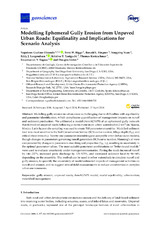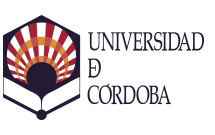Modelling Ephemeral Gully Erosion from Unpaved Urban Roads: Equifinality and Implications for Scenario Analysis

View/
Author
Gudino-Elizondo, Napoleon
Biggs, Trent W.
Bingner, Ronald L.
Yuan, Yongping
Langendoen, Eddy J.
Taniguchi, Kristine T.
Kretzschmar, Thomas
Taguas Ruiz, Encarnación
Liden, Douglas
Publisher
MDPIDate
2018Subject
Gully erosionUnpaved roads
AnnAGNPS model
Model equifinality
Urbanization
Watershed management
METS:
Mostrar el registro METSPREMIS:
Mostrar el registro PREMISMetadata
Show full item recordAbstract
Modelling gully erosion in urban areas is challenging due to difficulties with equifinality
and parameter identification, which complicates quantification of management impacts on runoff
and sediment production. We calibrated a model (AnnAGNPS) of an ephemeral gully network
that formed on unpaved roads following a storm event in an urban watershed (0.2 km2) in Tijuana,
Mexico. Latin hypercube sampling was used to create 500 parameter ensembles. Modelled sediment
load was most sensitive to the Soil Conservation Service (SCS) curve number, tillage depth (TD), and
critical shear stress ( c). Twenty-one parameter ensembles gave acceptable error (behavioural models),
though changes in parameters governing runoff generation (SCS curve number, Manning’s n) were
compensated by changes in parameters describing soil properties (TD, c), resulting in uncertainty in
the optimal parameter values. The most suitable parameter combinations or “behavioural models”
were used to evaluate uncertainty under management scenarios. Paving the roads increased runoff
by 146–227%, increased peak discharge by 178–575%, and decreased sediment load by 90–94%
depending on the ensemble. The method can be used in other watersheds to simulate runoff and
gully erosion, to quantify the uncertainty of model-estimated impacts of management activities on
runoff and erosion, and to suggest critical field measurements to reduce uncertainties in complex
urban environments.
